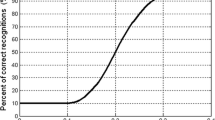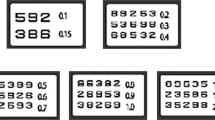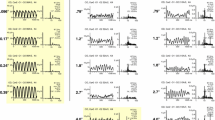Abstract
Background
Given the diversity of visual acuity tests being employed across the world, we compared two frequently applied tests: ETDRS charts and an eight-orientation projected Landolt C test in accordance with ISO 8596 and DIN 58220 part 3. The goals of the investigation were to determine (i) test agreement and (ii) test–retest reliability, to assess (iii) test durations, and (iv) the acceptance of the tests by the examinees as well as the subjects’ coping with the tests as rated by the examiner.
Methods
Seventy-five adult subjects with a visual acuity of ≥0.2 (4/20) were included in one of the following groups: normal, media opacity, maculopathy, optic neuropathy, (post)chiasmal lesion, or amblyopia. Visual acuity testing was carried out monocularly, in balanced randomized order and in two runs for each test on the same eye, applying forced choice.
Results
Agreement: Within each group, all tests were performed similarly, within ±0.048 logMAR. Reliability: Across all subject groups, with a probability of 95 %, test–retest differences were <0.18 logMAR for both ETDRS and Landolt tests. Duration: The Landolt test lasted, on average, 1.8 times longer than ETDRS charts (p < 0.001). Acceptance: Examinees preferred the ETDRS test (p < 0.001), the examiner on average had no preference.
Conclusion
The Landolt C test and the ETDRS test yielded comparable results in visual acuity and test–retest reliability in all disease groups. The ETDRS test was usually faster and more accepted by both examiners and examinees than the Landolt test.



Similar content being viewed by others
References
Bailey IL, Lovie JE (1976) New design principles for visual acuity letter charts. Am J Optom Physiol Optic 53:740–745
NEI Clinical Studies (2000) Early Treatment Diabetic Retinopathy Study (ETDRS). http://www.nei.nih.gov/neitrials/static/study53.asp. Accessed 14 Feb 2014
Kaiser PK (2009) Prospective evaluation of visual acuity assessment: a comparison of snellen versus ETDRS charts in clinical practice (an AOS thesis). Trans Am Ophthalmol Soc 107:311–324
International Organization for Standardization (2009) ISO 8596:2009 Ophthalmic optics—Visual acuity testing—Standard optotype and its presentation. http://www.iso.org/iso/home/store/catalogue_tc/catalogue_detail.htm?csnumber=52487. Accessed 10 Sep 2013
Deutsches Institut für Normung (2013) DIN 58220 Teil 3—Sehschärfebestimmung: Prüfung für Gutachten. http://www.nafuo.din.de/cmd?level=tpl-art-detailansicht&artid=189487179. Accessed 14 Feb 2014
Bach M (2013) Freiburg Visual Acuity & Contrast Test, homepage. In: Freibg. Vis. Test FrACT. http://michaelbach.de/fract/. Accessed 5 Jun 2013
Kuo H-K, Kuo M-T, Tiong IS, Wu PC, Chen YJ, Chen CH (2011) Visual acuity as measured with Landolt C chart and Early Treatment of Diabetic Retinopathy Study (ETDRS) chart. Graefes Arch Clin Exp Ophthalmol 249:601–605
Teichler G (2009) Untersuchungen zum Vergleich der Sehzeichen Landolt-Ring, E-Haken und Sloan-Buchstaben (ETDRS-Letters) sowie zur Reproduzierbarkeit der Visusbestimmung (with English summary). Thesis <http://geb.uni-giessen.de/geb/volltexte/2009/7249/>, Justus-Liebig-Universität
World Medical Association (1964) Declaration of Helsinki—Ethical Principles for Medical Research Involving Human Subjects. http://www.wma.net/en/30publications/10policies/b3/. Accessed 26 Apr 2013
Deutsche Ophthalmologische Gesellschaft (2013) Empfehlungen der DOG zur Qualitätssicherung bei sinnesphysiologischen Untersuchungen und Geräten. 7–23
Kingdom FAA, Prins N (2009) Psychophysics: a practical introduction. Academic, London
Heinrich SP, Krüger K, Bach M (2011) The dynamics of practice effects in an optotype acuity task. Graefes Arch Clin Exp Ophthalmol 249:1319–1326
Aitken RC (1969) Measurement of feelings using visual analogue scales. Proc R Soc Med 62:989–993
Wesemann W, Schiefer U, Bach M (2010) New DIN norms for determination of visual acuity. Ophthalmol Z Dtsch Ophthalmol Ges 107:821–826
Steinbeis Transfer Center Biomedical Optics and Function Tests—ETDRS Visual Acuity Tester. http://www.uak.medizin.uni-tuebingen.de/stz/etdrs.htm. Accessed 26 Apr 2013
Ferris FL 3rd, Kassoff A, Bresnick GH, Bailey I (1982) New visual acuity charts for clinical research. Am J Ophthalmol 94:91–96
Precision Vision Revised 2000 Series ETDRS Translucent Eye Charts for use in clinical studies and low vision evaluation. http://precision-vision.com/index.cfm/category/36/revised-2000-series-etdrs-charts.cfm?CFID=38487182&CFTOKEN=743288e2a63ab233-5A83B749-DB92-AA06-57F3F9DBE8BB3A57. Accessed 7 Aug 2013
Krzanowski W (2010) An introduction to statistical modelling, 1. Wiley, Chichester
Sheskin DJ (2007) Handbook of parametric and nonparametric statistical procedures, 4. Chapman & Hall / CRC, Boca Raton
Bland JM, Altman DG (1999) Measuring agreement in method comparison studies. Stat Methods Med Res 8:135–160
Cleveland WS, McGill R (1984) The many faces of a scatterplot. J Am Stat Assoc 79:807–822
Petersen J (1993) Erroneous vision determination and quantitative effects. Ophthalmol Z Dtsch Ophthalmol Ges 90:533–538
Rosser DA, Cousens SN, Murdoch IE, Fitzke FW, Laidlaw DAH (2003) How sensitive to clinical change are ETDRS logMAR visual acuity measurements? Invest Ophthalmol Vis Sci 44:3278–3281
Arditi A, Cagenello R (1993) On the statistical reliability of letter-chart visual acuity measurements. Invest Ophthalmol Vis Sci 34:120–129
Rassow B, Wang Y (1999) Correlation of letter optotypes with Landolt ring for different degrees of visual acuity. Klin Monatsbl Augenheilkd 215:119–126
Becker R, Teichler G, Gräf M (2011) Comparison of visual acuity measured using Landolt-C and ETDRS charts in healthy subjects and patients with various eye diseases. Klin Monatsbl Augenheilkd 228:864–867
Laidlaw DAH, Tailor V, Shah N, Atamian S, Harcourt C (2008) Validation of a computerised logMAR visual acuity measurement system (COMPlog): comparison with ETDRS and the electronic ETDRS testing algorithm in adults and amblyopic children. Br J Ophthalmol 92:241–244
Camparini M, Cassinari P, Ferrigno L (2001) ETDRS-fast: implementing psychophysical adaptive methods to standardized visual acuity measurement with ETDRS charts. Invest Ophthalmol Vis Sci 42:1226–1231
Lim LA, Frost NA, Powell RJ, Hewson P (2010) Comparison of the ETDRS logMAR, “compact reduced logMar” and Snellen charts in routine clinical practice. Eye (London England) 24:673–677
Rosser DA, Laidlaw DA, Murdoch IE (2001) The development of a “reduced logMAR” visual acuity chart for use in routine clinical practice. Br J Ophthalmol 85:432–436
Acknowledgments
We express our gratitude to the Deutsche Ophthalmologische Gesellschaft (DOG), which supported this research project financially. We thank our subjects for their participation in this study. Also thanks to the staff of the neuro-ophthalmologic department of the University Eye Hospital Tuebingen, where this study was carried out, for their support.
Conflict of interest statement
Author Ulrich Schiefer is consultant for HAAG-STREIT Inc., Koeniz, Switzerland and SERVIER Inc., Suresness, France.
All other authors: conflict of Interest—None.
Author information
Authors and Affiliations
Corresponding author
Rights and permissions
About this article
Cite this article
Koenig, S., Tonagel, F., Schiefer, U. et al. Assessing visual acuity across five disease types: ETDRS charts are faster with clinical outcome comparable to Landolt Cs. Graefes Arch Clin Exp Ophthalmol 252, 1093–1099 (2014). https://doi.org/10.1007/s00417-014-2670-y
Received:
Revised:
Accepted:
Published:
Issue Date:
DOI: https://doi.org/10.1007/s00417-014-2670-y




